Dreaming of completing a lap of Australia is something many of us do. It’s the ultimate road trip, an adventure of a lifetime that offers almost every type of terrain imaginable. Along the way, you will discover incredible places by accident, but some epic places should be jotted onto your dream map to make sure you don’t miss them. For this collection, we interviewed a number of travellers who had been on their own Australian road trips for their favourite places.
This post contains affiliate links. Our full disclosure policy is here.
Questions About the Big Lap
If you are planning your lap, you will have loads of questions. Many relate to distance and time that you need to cover it. Australia is 4000km from east to west and 3860 from north to south, and there are spots in each corner where you will be blown away.
Before we get into the must-see stops, here are some of the most common questions that come up when you begin planning.
How long do you need to do a lap of Australia?
The world record for completing a lap of Australia is 5 days, 13 hours and 43 minutes via Highway 1. This was achieved with four drivers, and the car was only turned off once in Darwin for a quick break.
Highway 1, the ring road that traverses Australia, is 14,500 km long
The average time to do a big lap is six to twelve months, and many say it is much more enjoyable if you can take a year or more. The least amount of time we would ever consider is four months, but you would need to be moving around at a decent pace and limit how many diversions you take—that kind of defeats the point.
Which direction should you take on your drive around Australia?
If it’s winter when you start, head north; if it’s summer, head south. Whether you drive clockwise or anticlockwise really should depend on your starting point and the time of year.
When is the best time of year for each state?
The most important thing to remember is that the north of Australia has a tropical climate with distinct dry and wet (humid) seasons. May until October is the ideal time to be at the top end. The East coast gets insanely busy in summer, pushing prices for campsites and accommodation through the roof, and southern Australia and Tasmania are cold and wet in winter.
What is the best vehicle for completing your lap?
Highway 1 is fully tarred, so technically, any roadworthy vehicle can make the trip. The two most significant factors here really are budget and comfort. We have made some longer trips in a motor home which we loved but had some drawbacks. We intend to buy a caravan next to allow us a bit more freedom to go off road.
Whether you have a camper trailer, a campervan or a high-end motorhome, make sure you have roadside assistance before you hit the road.
Have questions about exploring Australia?
Head over and join our Facebook Group and we will be happy to help
Places We Think You Should Include in Your Lap of Australia
We asked travel writers who have experienced some of Australia’s most impressive sites to share the spot they believe should not be missed.
Albany, Western Australia
The small town of Albany is on the southern coast of WA. If you’re planning a big road trip around Australia, it’s a stop you won’t want to miss! Albany is jam-packed full of stunning natural scenery, fascinating history and plenty of unique things to see and do.

A few of Albany’s best attractions are within Torndirrup National Park, a 20-minute drive from the town centre. The Gap is a massive split in the granite cliffs that run along the Southern Ocean. Take a walk to the viewing platform that hangs out over the cliff for a dramatic view. A short walk from The Gap will bring you to The Natural Bridge, an equally impressive rock formation.
Albany is home to some of the most beautiful beaches in the state. Little Beach in Two People’s Bay Nature Reserve is particularly scenic and one of the most popular beaches to visit near Albany. Not too far from there is Nanarup Beach, which is a local favourite and doesn’t attract the same crowds that Little Beach does.

Learn about Albany’s history by visiting the National Anzac Centre, a beautiful museum dedicated to the soldiers who fought in WWI. Don’t forget to stop at the Old Convict Gaol, where you’ll gain insight into some of WA’s first convicts.
Suggested by Ann Kelly from The Road is Life
Where to eat: Due South located on the waterfront serving delicious food with excellent views.
Where to stay: BIG4 Middleton Beach is a highly rated caravan park with a great location right on the beach.
Alice Springs, Northern Territory
Alice Springs is an outback centre worth spending time on your road trip. Explore museums that highlight central Australia’s pioneering history and discover the stunning natural landscapes between the East and West MacDonnell Ranges.
You’ll need at least three days or more to see the major sites in and around Alice Springs.
Of all the best things to do in the area is to visit Alice Springs, Desert Park where you can meet some of the outbacks unique creatures including thorny devils and the Australian Bilby.
The Desert Park is split into three desert habitats connected by pathways and a microcosm of the Australian outback and a place to experience the desert environment in one place. Here, you can learn the stories of the Arrernte people and hear the Akngwelye and Yeperenye Altyerre (Wild Dog and Caterpillar) dreaming stories. Visiting the park will show you why the Australian desert is such a special place.
Don’t miss the impressive birds of prey, ‘Nature Theatre’, where raptors fly freely in the sky. The demonstration is offered daily at 10 am in summer and twice a day at 10 am and 3 pm in winter.
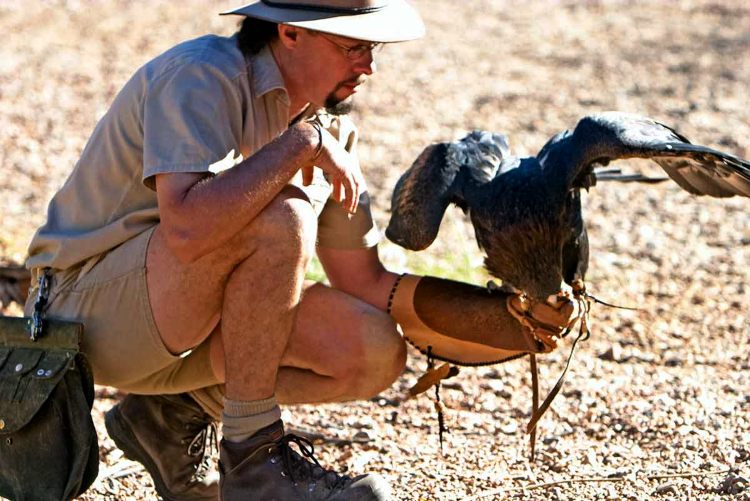
Where to eat: Red Ochre Grill Restaurant for modern Australian fare.
Where to stay: Discovery Parks Alice Springs with fire pits, a pool and water slides and a gym
Suggested by Christina from Travel2next
Atherton Tablelands, Queensland
One essential place to visit on a road trip through Queensland is the Atherton Tablelands. Situated just 90 kilometres southwest of Cairns, it is one of the best destinations to visit in North Queensland.
You will find interesting and quirky villages dotted throughout the tablelands, including the townships of Herberton, Mareeba, Millaa Millaa, and Yungaburra. On a drive through this region you will see lush tropical rainforests, volcanic lakes, waterfalls, national parks, and World Heritage-listed sites.

One of the must-see attractions in Atherton includes the Chinatown and Hou Wang Miau Chinese Temple in Atherton, which will provide an insight into the essential role Chinese settlers played in North Queensland.
If you would like to learn more about Australian pioneering history, you will love the Historic Village in Herberton. Also, a visit to Paronella Park should not be missed, but ensure you allow enough time for both the day and evening tours.
If you want to experience nature at its best, explore the Millaa Millaa Waterfall Circuit or visit the volcanic lakes of Lake Barrine, Lake Eacham or Lake Tinaroo.
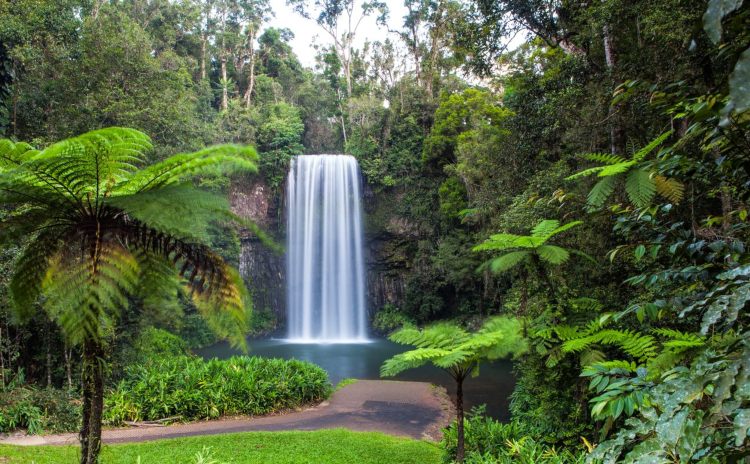
If you are lucky, you may even be able to spot a Platypus along the Peterson Creek Walking Creek in Yungaburra.
The town of Yungaburra is the perfect place to base yourself when exploring the Atherton Tablelands.
Recommended by Peta and Jonas of Exit45 Travels
Where to eat: The Yungaburra Hotel – good pub grub
Where to stay: Lakeside Caravan Park on Lake Tinaroo – located only 5 minutes from Yungaburra town.
Blue Mountains, NSW
Only 90km from the centre of Sydney, the Blue Mountains is one UNESCO site in Australia you should not miss. Its spectacular scenery is well known but the range of walking tracks to suit all abilities make it a must-see on any lap around Australia.
The Dharug and Gundungurra are the Traditional Owners of the land encompassed by the Blue Mountains
The area was mined for coal in the 1800s, but when the coal seam was exhausted, it became a tourist town. It quickly gained popularity with day-trippers from Sydney looking to escape the heat.
By the mid-1920s, it was a popular weekend destination, and there are many gorgeous historic properties and lavish gardens that date back to this period.

Pop into the Carrington Hotel for a drink or the Hydro Majestic for coffee and cake to experience the grandeur of the early days. History lovers should also book a tour with Mountain Tales. Sue the owner has done significant first hand history to be able to tell the stories of the mountains towns and villages. I have done all her tours and loved them.
There are more than 30 lookouts in the Blue Mountains, many only a short walk from the roads. One easy walk that should not be missed is the 2km Katoomba Cascades walk which is also floodlit at night, allowing you to see the mountains after dark. It’s suitable for most abilities.
Where to eat: In Leura, we recently enjoyed The Bunker at the top of Leura Mall and in Katoomba visit the Bowery, great food in a stunning old building.
Where to stay: The Blue Mountains Tourist Park – Katoomba Falls is a great base. Alternatively, there is another caravan park at Blackheath. If you are not travelling in a van or camping, there is a huge range of accommodation at every price point.
Cairns, Queensland
Cairns, or Gimuy-walubarra Yidi, as it is known traditionally, is an essential part of any trip through far north Queensland. Not only is the city itself a great place to base yourself for a few days of sunshine and relaxation. It is also the perfect destination to take in some of the many day trip options from Cairns!
While Cairns itself is not the place you go if you want to spend your days lazing on the beach, there is so much to do within the city or nearby.
There is a free swimming pool in the centre of town, playgrounds and wildlife attractions within walking distance from the city centre.

Take a day tour of the outer Great Barrier Reef. This experience is a perfect way to experience a small part of the reef with snorkelling, glass-bottom boat tours and plenty of fun in the water.
If the idea of being in the middle of the ocean makes you nervous, a Green Island day trip is a wonderful alternative and only a short 45-minute boat ride from Cairns Marina. From here you can snorkel right off the beach with a lifeguard on duty making it a great choice for families or those who get a bit seasick and don’t want to spend a day on a boat.
Another must-do is riding the train up the mountain to Kuranda and catching the Skyrail back down for aerial views over this beautiful part of Australia.
Check out our full list of things to do in Cairns once you have seen the reef.
Suggested by Holly from Four Around The World
Where to eat: For a casual lunch, try Hemingways Brewery. For dinner, Ochre Restaurant on the Marina.
Where to stay: Shangri-La, The Marina, Cairns or NRMA Cairns Holiday Park
Charleville, Queensland
You will find the outback Queensland town of Charleville 683 km west of Brisbane, at the intersection of the Warrego and Mitchell highways. Charleville is set on the picturesque Warrego River and is home to about 3300 people.
The traditional owners of the land around Charleville are the Bidjara people.
The town is a convenient stopover point on the way to pretty much anywhere else in Queensland, with reasonable motel accommodation and caravan parks, and some decent places to eat.
The most popular things to do in Charleville are visits to the Cosmos Centre, the WW2 secret airbase and the Bilby Centre. The Cosmos Centre offers visitors the opportunity to observe the night sky through its large telescopes. Book in advance to avoid disappointment and keep your fingers crossed for a cloudless sky.


A visit to the recently opened Secret military base at Charleville is an absolute must. The tour guides are very knowledgeable and enthusiastic about the base’s history and its role during WWII. The base was home to 3500 United States Army Air Force personnel in the mid-1940s.
The Bilby Centre, located next to Charleville’s train station, is dedicated to protecting this native Australian species from extinction. They have raised funds, educated people and also made great strides to reintroduce the endangered Bilby back into parts of Queensland.
There is also an opportunity to observe some of the Bilbys living at the centre – a rare opportunity to see this rare Australian animal.
Where to eat: On the Rocks Restaurant has a great range of vegetarian meals alongside some serious outback steak and rib offerings.
Where to stay: Bailey Bar Caravan Park offers impressive outback hospitality with meals available three nights a week and hobby horse racing on Wednesday nights.
Coober Pedy, South Australia
Coober Pedy may just be the most weird and wonderful place in Australia. In the heart of the outback in South Australia, it’s famous for being the opal mining capital of the universe and home to a community that mostly lives in underground houses.

The town’s name comes from the Aboriginal words Kupa Piti – meaning “white man in a hole”.
It earned that name for the fact that since the early 20th century, white men have been coming here to seek their fortunes, lured by the promise of buried treasure – opal.
Opal is one of the world’s most precious gemstones, but unlike diamonds or gold, it cannot be mined industrially. So individuals can come here, stake a claim, and start digging. Over the decades, this has led to a bizarre but otherworldly landscape, full of mineshafts and spoil heaps, that looks like alien creatures have been burrowing here.
It’s so hot and dusty in the desert environment that many people live in houses underground where it’s cooler. This gives the town an eerie, remote feel, but it’s definitely unique. Visit the opal mining museum to learn about the industry’s history and see some impressive opals, take a trip out to the opal fields, or even try your luck searching for opal yourself!
Suggested by Bella from Passport & Pixels
Where to eat: John’s Pizza Bar is a local institution, centrally located, with a vast range of toppings to choose from.
Where to stay: Try the Underground Motel for the authentic Coober Pedy experience. Alternatively, the Big4 Stuart Range Outback Resort is a great option when travelling with a van or tent.
Cooktown, Queensland
Not surprisingly, a bucket list destination for many people on a Lap of Australia is the tip of Cape York, the northernmost point in Australia. However, unless you’ve got a proper 4WD, plus plenty of experience and determination, it’s out of reach for many travellers. Instead, consider heading to Cooktown.
Cooktown is the northernmost town along Australia’s East Coast, about 170km north of Cairns. The most direct route from Cairns is along the Bloomfield Track, a 4WD route that hugs the coast north of the Daintree. However, if you’ve got a 2WD or a caravan, instead, take the inland Mulligan Highway, sealed relatively recently in 2006.
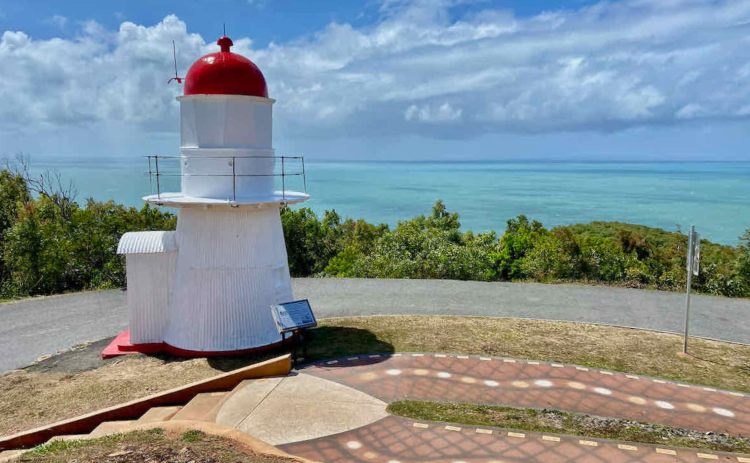
Arriving in Cooktown feels like arriving in Cairns as it must have been decades ago, just a sleepy small town located on the Endeavour River. The town has a long history dating back to a nearby gold rush in the 1870s, but its isolation has kept it a backwater.
Cooktown is most famous for its visit from Captain Cook, after whom the town is named.
While in Cooktown, a popular spot to visit is the James Cook Museum, don’t also overlook the perspective of the local Aborigines, who call the area Gangaar. Make sure you visit Reconciliation Rocks and the Milbi Story Wall. The local Botanic Gardens are also impressive.
If you are travelling to Cooktown with your four-legged friend, check out this dog-friendly Cooktown guide.
Suggested by Shandos Cleaver from Travelnuity.
Where to eat: Head to the Cooktown Hotel for pub food and cold beers.
Where to stay: The Cooktown Caravan Park, which promises to be midge-free, is a great choice!
Coral Bay, Western Australia
Australia has no shortage of seaside holiday spots, but few compare with Coral Bay. This small holiday town, 1100km north of Perth, has easy access to the world heritage listed Ningaloo Reef. From your accommodation, it is a short walk to the beach, then an even shorter swim onto this fantastic coral garden.

Ningaloo Reef is home to hundreds of colourful fish, sea turtles, rays and dugongs. Whether you snorkel in Bills Bay or drift along Paradise Beach, it’s all as little as 50 metres from shore.
Besides snorkelling, you won’t find a prettier spot to launch a stand-up paddleboard or kayak or go for long walks on the beach. The accessibility of the reef and sheltered bay makes this a brilliant location for families.
The best time to visit Coral Bay is from May to October.
For an unforgettable experience, go on a wildlife cruise. Coral Bay has a resident population of manta rays. The tours not only give you a chance to swim with them, but you’ll also cruise through a turtle sanctuary and get to snorkel on the outer reef.
Suggested by Natalie from Curious Campers
Where to stay: Ningaloo Coral Bay Bayview–is big, bustling, and has a great holiday vibe, perfect for families.
Where to eat: Fin’s Café–located outside The People’s Caravan Park. Fin’s has a great range of food. The outdoor area is the perfect setting to relax after a day in the water.
Exmouth West, Australia
When taking an Australian road trip, the journey to Exmouth in West Australia may take a little extra effort, but once there, you will discover one of the most beautiful places in Australia.

Driving to Exmouth, you will pass a vast desolate terrain that is breathtaking in its harshness. Hidden within this stark landscape are the pristine waters of the Ningaloo Coast World Heritage Area and the rugged grandeur of the Cape Range National Park.
Exmouth has many natural attractions and is famous for the majestic whale sharks that visit the region between March and August. Whale watching is also popular, and the best time to see them is during their migration between June and November.
To get a bird’s eye view of Exmouth, head up to Vlamingh Head Lighthouse to see stunning panoramas of the coastline and Cape Range National Park.
One of the most spectacular beaches is Turquoise Bay, which has bright white sand and vibrant turquoise waters. We enjoyed our time here swimming with fish around us, it was perfect for snorkelling.

Another good snorkelling beach is Lakeside. Just a short 500-metre walk from the car park, you can snorkel straight from the beach in the Lakeside Sanctuary Zone.
The Cape Range National Park has several walking trails, and one of the most picturesque is the Yardie Creek Trail, a family-friendly trail with views of Yardie Creek and Gorge.
Suggested by Ros Cuthbertson from Road Trip Australia
Where to eat: Stop by Whalebone Brewing for some beer and pizza
Where to stay: RAC Exmouth Cape Holiday Park has a stunning resort-style swimming pool and a large well set-up camp kitchen. It’s also pet friendly on request.
Flinders Ranges, South Australia
The Flinders Ranges are a mountain range located in South Australia. They are home to the tallest mountains in the state. Often called “South Australia’s Outback”, we found them every bit as unique and beautiful as the red centre.
The ranges cover an area of 1,800 km² and span across the border between South Australia and the Northern Territory. They are home to many species of plants and animals, which are found nowhere else in Australia.

The best-known feature of the area is Wilpena Pound, a natural amphitheatre that is a sacred place for the traditional owners and was once part of a vast station owned by the Hill Family.
Adnyamathanha people are the Traditional Owners of the Flinders Ranges area, including Wilpena Pound (Ikara)
Flinders Ranges was named by South Australian Governor Gawler in 1839 after explorer Matthew Flinders, who explored and mapped the area in 1802.
Wilpena Pound is a popular place for bushwalking and photography. There are walks for all abilities from beginners to those after a challenging hike. We enjoyed a sunrise walk to Wangarra Lookout which was a 7.2km return, with only the final section to the top lookout being challenging. Alternatively, you can finish at Hills Homestead for a 6km easy return hike.
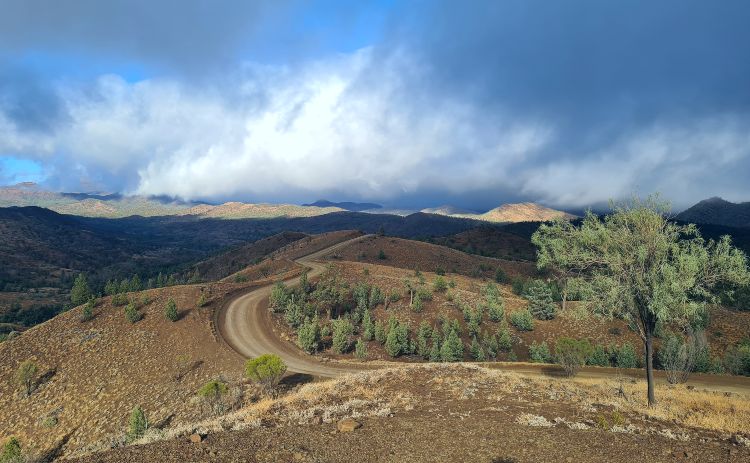
The colour and diversity of the landscape are among the most beautiful I have seen. Be sure to include a drive along the Brachina and Bunyeroo Gorge Scenic routes. We only had a two-wheel drive SUV, and it was okay, but if there had been any rain, it would have been too tricky, so check the weather and road conditions with the visitors centre before heading out. Or better still, join a guided tour, either a drive-along or a full escort if you don’t have your own vehicle.
We suggest you spend at least 3-4 days in the area; we had three nights and four days and would have happily stayed longer. A week would pass easily here if you have the time.
Where to eat: Flinders Fine Foods in Hawker was the best meal of our visit, and we have it at the top of our list when we return.
Where to stay: Wilpena Pound Resort or Rawnsley Park Station are both excellent choices with everything from campsites to comfortable rooms available.
Grampians National Park, Victoria
Grampians National Park – also known as Gariwerd National Park – is a stunning reserve 255km from Melbourne. The natural beauty and the rich biodiversity here are breathtaking. If you’re interested in short day hikes and exploring flora and fauna, the Grampians National Park is definitely for you. This heritage site is also known to be some of the best indigenous rock art sites in all of Australia!
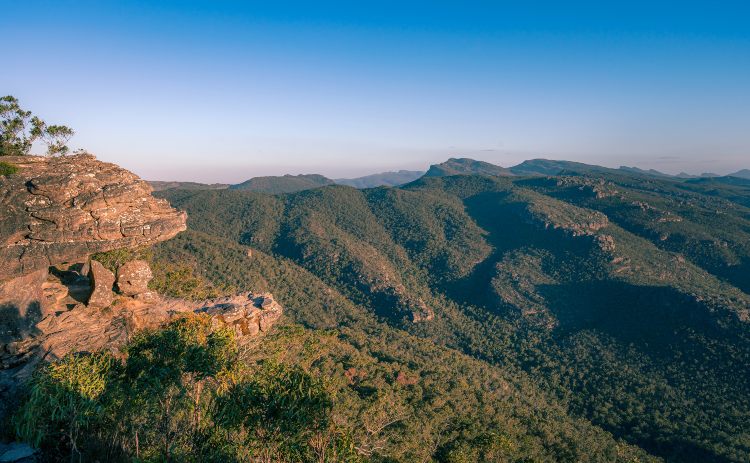
The park has several small towns and villages in it. One of the most popular of these is Halls Gap. Halls Gap is an excellent base with campsites, caravan parks, and hiking trails nearby.
A short sunset hike up the Pinnacle lookout is highly recommended . Overlooking many different peaks of the national park its a view you will remember.
Another more demanding hike one can do is up to Mount William – or Mount Duwil – which is the highest peak in Grampians National Park. Apart from these two walks, strolling through the flatlands of the park and bumping into kangaroos and emus is a great way to spend your time!
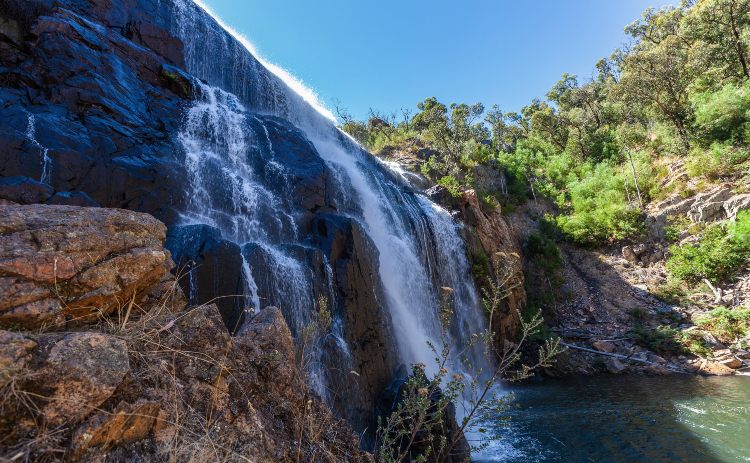
Where to Stay: Breeze Holiday Parks in Halls Gap has wood cabins, as well as a dedicated caravan park. The park also features a community kitchen, free wifi, a swimming pool and a play area for kids.
Suggested by Avantika, from Wayward Wayfarer
Great Ocean Road, Victoria
The Great Ocean Road is a 243-kilometre stretch of coastline in the southeast of Australia extending from Torquay in Victoria to Allansford near Warrnambool. This coast road was built as a memorial to those who lost their lives at sea during World War I and is now one of Australia’s most famous tourist attractions.
The Twelve Apostles is the third most recognised natural landmark in Australia after Uluru and the Great Barrier Reef.

There are several places we suggest you stop off along the drive. These include Split Point Lighthouse at Aireys Inlet, the Great Ocean Road Memorial Arch near Lorne, Mariners Lookout near Apollo Bay, Cape Otway Lighthouse and finally, the 12 Apostles Visitors Centre.
Staying somewhere near the visitor’s centre is a good idea as this allows you to view the rock formations at sunset and sunrise the following day.
The next day continues to Warrnambool via Loch Ard Gorge, The Arch, London Bridge and The Grotto and the Bay of Islands National Park.
If you are returning to Melbourne, allow half a day to visit the waterfalls in Otway National Park. These are quite beautiful and not too challenging to reach.
Check out our easy to follow 2-day itinerary for more ideas.
Where to eat: The biggest range of cafes and restaurants are in Port Campbell. We enjoyed the coffee at Grassroots Deli Cafe and breakfast at Forage on the Foreshore.
Where to stay: Princetown Recreation Reserve and Camping are the closest to the visitor’s centre. There are also plenty of motels and bed and breakfast style offerings nearby.
Kangaroo Island, South Australia
Off the coast of SA, at the tip of the Fleurieu Peninsula, Kangaroo Island offers some of the best coastal drives in Australia. The natural beauty of the landscape and the diversity of its wildlife make it one of our favourite places in the country.
Among Kangaroo Island’s biggest attraction is its beaches. There are many to choose from, with each one offering something different. We loved Pennington Bay and Vivonne Bay on the south coast and Emu Bay on the North Coast.

The wildlife on Kangaroo Island provides many opportunities to experience the Australian wilderness in a way that you might not otherwise. Watching the sea lions at Seal Bay, the seals at Admirals Arch and swimming with the dolphins are as much fun as meeting the kangaroos and the koalas.
The island also has a fantastic local food and wine industry, with many small producers to visit. Don’t miss Bay of Shoal wines with fabulous water views matching the delicious wines. On the south coast, False Cape and Dudley Wines have beautiful cellar doors.
You can see what we got up to on our five-day visit here
Where to eat: There are not many dining options on the western end of the island. In Kingscote, we enjoyed Bella Cafe and Pizza Bar.
Where to stay: Western Island Caravan Park
Kings Canyon, Northern Territory
Watarrka National Park is an incredible natural reserve within Northern Territory. It’s between the famous Uluru and Alice Springs, making it a great stop on your way to the belly button of the earth. The national park has a rugged beauty with lots of canyons, red rock mountains, and unique rock formations and landscapes that you won’t usually see in the rest of the world.

One of the most visited places in the park is the Kings Canyon. This is an exciting hiking spot for active travellers and has some truly breathtaking views.
The most challenging part of the hike is the first 15 minutes, as more physical strength is required to climb the steep slopes to the top of the canyon; after that, it is a rather pleasant walk on the edge of the canyon descends to the lower ground.
While you are walking on the rocks, check out the ripples on the stones that were carved by lake water and wind. Looking up, the entire plateau is covered by beehive-like domes, also carved by wind and rain through a process in the last 20 million years.
If you plan to stay there for a few days, there are various campsites in the area with cooking and showering facilities. Nothing beats a barbecue dinner and a night in swag to stargaze.
Where to eat: The Outback Bar and Grill at the resort is your best bet. There is not a lot of choice, so perhaps bring some supplies with you.
Where to sleep: Kings Canyon Resort has all accommodation levels, from five star to a well-appointed campground.
Suggested by Kenny Chow from Knycx Journeying
Lakes Entrance, Victoria
One place you have to visit on your lap of Australia is Lakes Entrance in eastern Victoria. This fantastic seaside town is packed with things to do. From the famous 90-mile beach to mighty mountains a short trip away, you will find plenty to keep you busy.
Lakes Entrance is the largest coastal town on the Gippsland Lakes. The Gippsland Lakes are over 350 square kilometres of marshes, lagoons and lakes, which hold some amazing boating, fishing and unique wildlife opportunities.
The area is home to the Burrunan dolphin, only found in the lakes system and Port Phillip Bay. Seals rest on the rocks of the entrance or play in the waves on a choppy day.

If fishing or boating is not for you, sample some of the fresh food on offer. Many shops sell local produce, with most nearby towns having a farmers’ market on the weekends. From cheese to fresh fruit and craft beer, there is always something delicious on offer.
From Paynesville, you can take the 5-minute ferry ride to Raymond Island Koala colony.
From Lakes Entrance, you can also do some day trips to some old mountain towns like Omeo and Orbost. Learn about the mountain cattlemen that rode through the high country of Gippsland, see the mighty Snowy River or walk through some amazing Aussie bush.
Recommended by Bec from Explore Victoria Australia
Where to stay: One of the most popular caravan parks is the Eastern Beach Caravan Park. It is an easy walk or ride into town. Alternatively, check out the nearby villages. Metung and Paynesville are two of the most popular as they still have all the necessities that lappers need.
Lightning Ridge, NSW
I think Lightning Ridge is one of Australia’s unique places and should be included on every lap of Australia. Along with learning more about opals and soaking in the town’s free thermal pool, you may encounter some friendly and unique locals.

Take all or at least a few of the Car Door Tours, while a four-wheel drive is best for most of these you can do parts with a regular car, the visitors’ centre will let you know which ones are suitable for you. They also sell maps for $1 that are invaluable.
Artist John Murray calls Lightning Ridge home and has a gallery there. You will also notice some pretty cool street art around the town’s main streets.
We also recommend that you make the drive to Nettleton’s First Shaft Lookout for the best sunset in town.
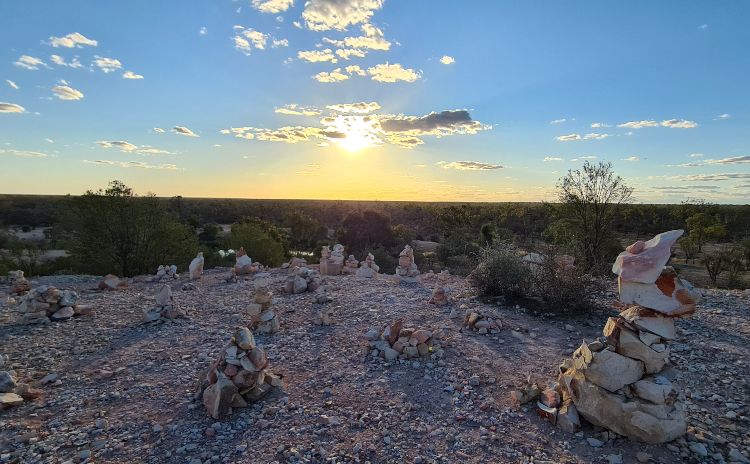
Where to eat: We cooked most of our meals in the van. The local IGA has fantastic prices and a great range of ready-made meals and things for easy to pull together feasts.
Where to stay: We spent three nights at Lightning Ridge Holiday Park and loved it. The owners are fabulous, and the park is friendly and close to everything you need. It’s a three-minute walk to the supermarket and restaurants, and many of the town’s sites are within walking distance.
Magnetic Island, Queensland
Tropical Magnetic Island, known as Yunbenin by the Wulgurukaba people, is known for palm-lined beaches and a generous supply of sunny days, making it a great addition to the lap of Australia, particularly when the weather cools down south.
Take your vehicle or hire one island-side. Sealed roads connect five bays, and with a 4WD, you can visit West Point for a secluded sunset.

Vehicular and passenger ferries leave from Townsville NQ, taking 40 minutes and 15 minutes, respectively. The arrival point of Nelly Bay has supermarkets, cafes, chemist, vehicle hire and Real Estate office, although accommodation is best booked ahead.
With 26km of island walking tracks, most of which are in National Park, Magnetic Island offers plenty of opportunity for spontaneous wildlife encounters. Look for koalas on the Forts Walk, which takes in real Military Forts and artillery sites from WWII. Alternatively, meet wild wallabies at Arcadia Wharf without stepping off the tarmac.
My favourite island day is boulder climbing above the bays, a cooling ocean dip and snoozing beneath the beach Casuarinas, but it has fun water sports, boat trips, snorkelling trails and diving.
Suggested by Jan from Budget Travel Talk
Where to Eat: Scallywags in Nelly Bay is a bright and breezy Pirate themed café for all the family. Open from 7 am. Indoor kids play area. They are known for fantastic breakfasts and burgers. BYO.
Where to Stay: Pure Magnetic Villa 4 in Nelly Bay is 50 metres from the Beach, fully self-contained with air-conditioning and a Share Pool. Bungalow Bay has great campsites.
Margaret River, Western Australia
Margaret River is a small, picturesque town situated around three hours south of Perth, within the Boojarah region of Noongar Country.
The area is renowned for its food, wine, and surf. The region is home to over 200 wineries that produce some of the country’s best Cabernet Sauvignon and chardonnay. Beer lovers will not miss out, though, as there are a handful of craft breweries, as well as artisan distilleries in the area.

You will not be disappointed when dining out; from quirky cafes to fine dining, Margaret River has it all! There is an abundance of fresh and local produce to sample, such as specialty cheeses, olives, chocolate, and venison.
Arrange a wine tour before arriving–you will need a car to reach the wineries and a driver to ensure you can safely make the most of your tastings.
Margaret River is also home to some stunning landscapes, including spectacular underground caves of limestone, plenty of bushwalk trails and lookouts, and excellent beaches.
Contributed by Nadia Cuthbertson from Perth Weekend.
Where to Eat: Leeuwin Estate offers a fantastic degustation lunch–The Ultimate Leeuwin Tasting Experience. Enjoy seven courses, each paired with wine, while overlooking the beautiful landscape.
Where to Stay: Margaret River Tourist Park has a swimming pool and free BBQ facilities. It’s ten minutes from Prevelly Beach and a good choice for visitors wishing to stay close to the attractions.
Mornington Peninsula, Victoria
The Mornington Peninsula is a glorious region of Victoria just south of Melbourne, which offers some of the state’s best places to stay, eat and play. It is also the most popular Victorian coastal holiday spot, so it is a destination that requires a little planning when it comes to securing reasonable accommodation! Add to the list its reputation as foodie heaven, and you have a region worth adding to your Lap of Australia.
The Mornington Peninsula is Boon wurrung/Bunurong Country
Local attractions include Arthurs Seat, Peninsula Hot Springs, Ashcombe Maze and Lavender Gardens; glorious coastal towns such as Sorrento, Portsea and Mornington; wineries; and incredible Farm Gates to secure local produce and even pick some yourself!

With its collection of seaside towns and bevy of beaches, you will have a hard time deciding which to stop at on your trip. My top picks to visit are; Sorrento and Portsea Back Beaches, Point King, and Portsea.
While the beaches usually entice visitors to explore the area, the Peninsula Hot Springs are my favourite spot in the region for the ultimate relaxation and indulgence.
Making use of the area’s geothermal mineral spring, the Peninsula Hot Springs boasts numerous bathing areas that are spread out across the grounds. It is total bliss. Make sure to head to the stunning hilltop pool with its panoramic views across the Mornington Peninsula, which, from 10.00 am each day, is only open to adults.
Hot Tip: if you want to get to the Great Ocean Road quickly, you can take a ferry from Sorrento across to Queenscliff. It doesn’t save that much time, but it is an experience to cross Port Phillip Bay, and you may spot a whale or dolphins (plus it’s a break from driving)
Where to Eat: Ten Minutes by Tractor, The Rye Hotel or the Rye Hotel are great choices.
Where to Stay: Make sure you book way ahead of time as accommodation books out far in advance of school holidays and long weekends. Big 4 Mornington Peninsula is a great choice.
Suggested by Leah from Kid Bucket List
Mount Gambier, South Australia
The second-largest city in the state, Mount Gambier, is full of unique geological wonders, and for this reason, is a must-stop on your lap of Australia.
Home of the Booandik people, the Mount (as the locals call it) is the bustling city and the heart-beat of the Limestone Coast. Located halfway (400kms) between Adelaide and Melbourne, this is a great place to stop when road tripping between the two capital cities.

The most famous of Mount Gambier’s attractions is the Blue Lake. This stunning lake is a large crater lake on the edge of town and, as the name suggests, is breathtaking in its blue colour, especially between December and March.
Approximately a kilometre across and around 75 metres deep, a fantastic walking trail around the crater rim gives plenty of viewpoints for spectacular photos.
Next door to the Blue Lake is the Valley Lake, with excellent picnic areas and other hiking trails.
Another spot to add to the list is the Umpherston Sinkhole. Being that Mount Gambier is in the Limestone Coast, the limestone in the area is easily eroded, allowing for caves and sinkholes. Right in the centre of the town, this giant sinkhole can be explored via stairs to the stunning gardens located within the sinkhole.
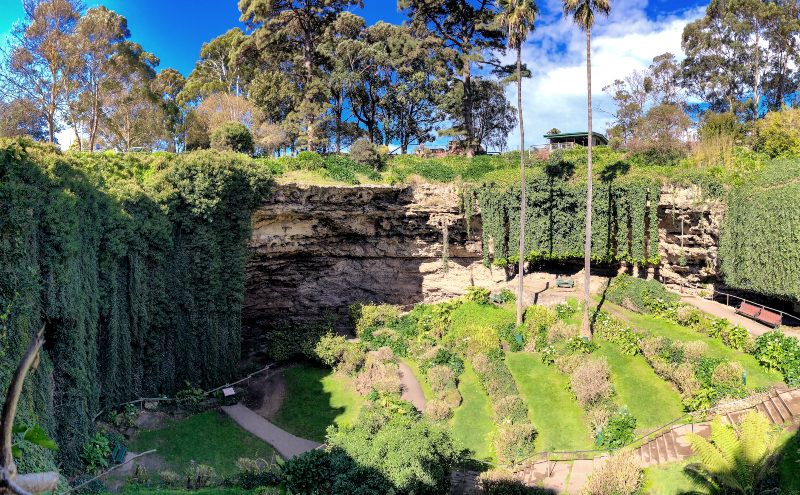
Other attractions to visit while in Mount Gambier include Engelbrecht Cave, the Cave Gardens and for the more adventurous, go diving at either Ewens or Piccaninnie Ponds, which are freshwater diving sites with crystal clear water.
By Lauren – South Australia Road Trips
Where to Eat: The Barn in Mount Gambier is known for fantastic food and would be my recommendation.
Where to Stay: Check out the Blue Lake Holiday Park or The Barn Accommodation if you fancy a night out the van.
Mount Tamborine, Queensland
Mount Tamborine is a charming little village nestled in a picturesque area of the scenic rim. A short 40-minute day trip from the Gold Coast, this popular town is a great place to connect with nature, stock up on delicious produce, catch a breathtaking sunset and buy a quirky souvenir. A great change of scene from the fabulous Gold Coast beaches.
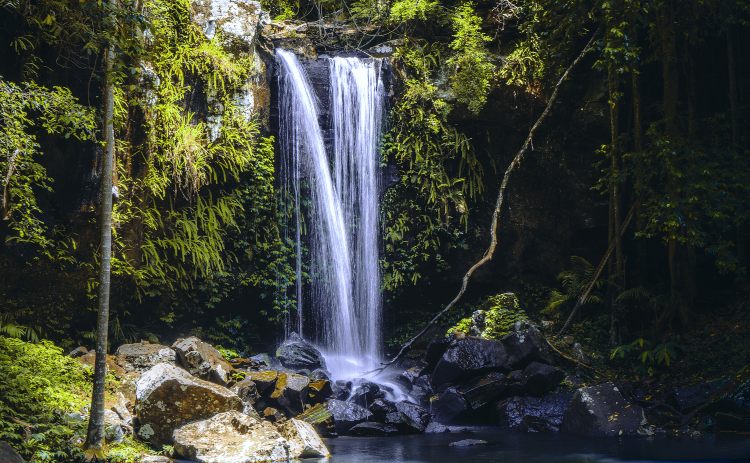
There are many walking tracks in Mount Tamborine suitable for all fitness levels. One of the favourites is Curtis Falls, where you are surrounded by ancient sub-tropical rainforests and rewarded with a waterfall on the forest floor. It’s an easy 1km walk to view the falls, and if you are fortunate, you might spot a platypus!
Cedar Creek Falls is the spot for a refreshing swim with the water cascading into a series of spectacular plunge pools.
For a bird’s-eye view, visit the Mount Tamborine Skywalk, where you walk amongst the treetops at an incredible 30 metres above the rainforest and creek below.
Mount Tamborine is a haven for foodies, with boutique wineries, a distillery and a variety of cafes and restaurants. You will find most of the dining options along Gallery Walk, there are also unique stores, including fudge, fashion, craft, and gift shops.
For a change in pace, throw down a rug or take a stroll in the beautiful Tamborine Mountain Regional Botanic Gardens in the Scenic Rim. Boasting a range of colourful native and exotic flora, the gardens have a tranquil lake setting as their centrepiece and are the perfect place to watch the day fade away.
Suggested by Sharee from Inspire Family Travel
Where to eat: Three Little Pigs Bar and Bistro is a must for anyone who loves pork belly!
Where to Stay: Southern Sky Glamping is a great spot to spoil yourself a little
Narooma, NSW
Known for its pristine beaches and different shades of blue waters, Narooma is on the south coast of New South Wales. Initially inhabited by the Yuin people and the traditional owners Walbunja clan, the name Narooma is derived from an Aboriginal word that means clear blue waters.
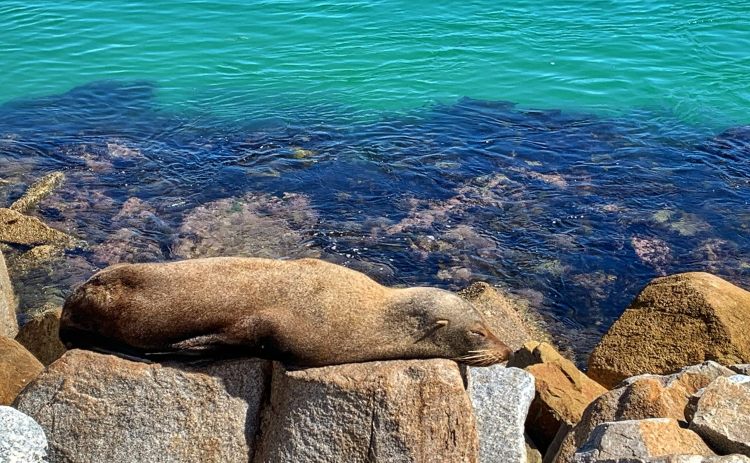
Narooma has spectacular rock formations along the beaches. The most famous are the Camel, Horse Head, and the Australia Rock formations.
The bay just opposite the Australia rock is also home to many seals with a large seal colony. You can go swimming with seals at a nearby Montague Island on a guided tour from Narooma.
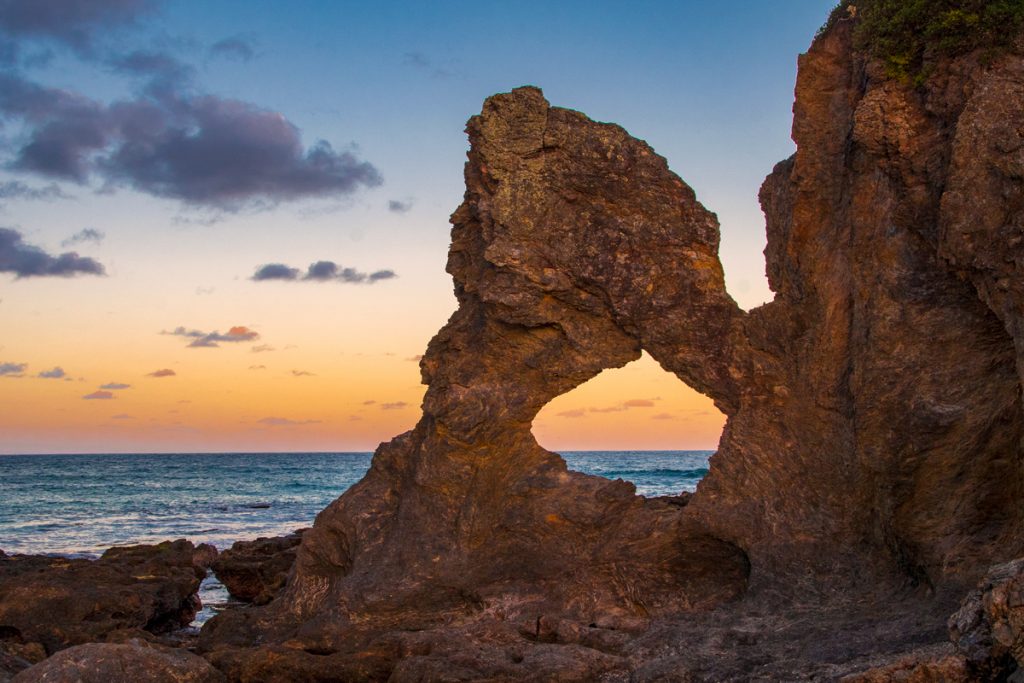
There is also a lighthouse that is not active, which now serves as an information centre.
With so many options for sightseeing, the coastal town of Narooma indeed makes a perfect stopover on a road trip along the east coast of Australia. It is best to spend at least two or three days in this town to experience everything that it offers.
Suggested by Raksha from Solo Passport
Where to stay: Narooma has a gorgeous holiday park called the Surf Beach Holiday Park. Along with being a budgeted stay option, it also provides camping sites right next to the lake.
Strahan, Tasmania
Strahan (pronounced strawn–like prawn) is a must-see stop on your lap of Australia. It’s unique, and it won’t be a destination that fades into all the rest. On the west coast of Tasmania, the drive here through the ancient rainforest will help you feel like you have left civilisation behind. Despite its isolation, this town of only 700 is picturesque and punches far above its weight for tourist attractions.

Strahan was once an important port for nearby mining settlements and the timber industry that once operated around Macquarie Harbour. It’s close to Sarah Island, an infamous penal colony best known for being the harshest in Australia. This past has left some interesting attractions and plenty of beauty in its position on the edge of Tasmania’s Wilderness World Heritage Area.
There are two major attractions in Strahan that you have to do. The first is a cruise on the Gordon River. The stark beauty of this area is mesmerising. These tours also include stops and tours at the Sarah Island penal settlement and Heritage Landing, where you can get up close to the rainforest and Huon pines. The second is a ride on the West Coast Wilderness Railway. Built for mining companies, this stretch between Strahan and Queenstown through the rainforest on+B25, the rack and pinion gear system built into the tracks and the engine is quite a journey.
Suggested by Sharon from Tasmania Explorer
Where to eat: Hamer’s Bar and Bistro in the middle of Strahan’s waterfront area
Where to stay: Big 4 Strahan or Strahan Beachside both offer powdered and unpowered sites. Ormiston House for atmospheric bed and breakfast style accommodation.
The Tasman Peninsula/Turrakana
If you like a mix of history, nature and cool, quirky things, then you can’t miss out on exploring the Tasman Peninsula in Tasmania. Most famous for being home to Port Arthur, one of the most notorious convict settlements in Australia, these days it is equally popular because of the many natural sites and excellent bushwalking opportunities – not to mention the possibility of seeing lots of native wildlife!

Famous natural sites include the “Devil’s Kitchen”, Tasman Arch, and the Tessellated Pavement.
The Tasman Peninsula is also a key area for the work to save the Tasmanian Devil from devil facial tumour disease. Visit the Tasmanian Devil Unzoo here if you want to guarantee sightings of these cute critters, as well as get to hand-feed wallabies while helping to fund devil conservation.
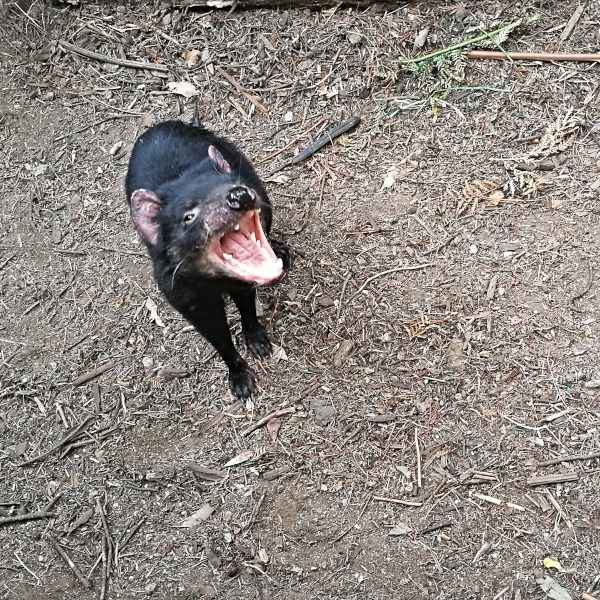
It takes a bit over an hour to drive from Tasmania’s capital city of Hobart to the peninsula, which makes it ideal for exploring as a day or overnight trip. Still, I think it’s best enjoyed over a couple of days so you can get to see everything.
Suggested by Kristy from Tassie Devil Abroad
Where to eat: Port Arthur Lavender has a lovely cafe with lavender-flavoured ice-cream, cakes, pancakes and more, as well as ‘regular’ yummy meals.
Where to stay: NRMA Port Arthur Holiday Park is ideally located 2.5km from the Port Arthur Historic site. It has great facilities, including a wood-fired pizza oven, fire pits and free wifi.
Uluru, Northern Territory
One of the country’s most recognisable natural landmarks, Uluru, is an essential stop on any trip to or within Australia. Like an iceberg rising out of the desert, the famous monolith rises 348 metres, with an estimated 2.5 kilometres of its bulk underground.

The magnificence of Uluru can be appreciated in various ways. There are several viewpoints to admire the fiery red or rich pastel colours produced at sunrise or sunset.
One of the best ways to experience the diversity of Uluru is to walk or cycle its 9.4-kilometre base.
It’s an opportunity to explore the lush green belt and numerous waterholes that were an abundant source of food and water for the Aṉangu. Admire the beautiful examples of rock art that provide a vital historic and scientific record of the human occupation of the region.
Suggested by Anne Betts from Packing Light Travel
Where to stay: A variety of accommodation to suit all budgets and preferences is available at Yulara, 18 kilometres from Uluru. The complex also includes restaurants, a supermarket, a gas station, tour booking services, and other essential services.
Wineglass Bay, Tasmania
Wineglass Bay is a jewel on Tasmania’s beautiful coastline and is a destination you should not miss. With pristine white sands and turquoise waters framed by mountains, the landscape is truly breathtaking. Wineglass Bay rates as one of the most beautiful beaches in the world.
From the Wineglass Bay Lookout, there are sweeping views over the Bay and the surrounding coastline. It’s a short walk to the lookout, and there are some steep sections on the popular trail. The path continues steeply down to Wineglass Bay Beach, where you can relax on the sand or swim in the crystal clear water.
Freycinet National Park has many beautiful walking trails and scenic spots to visit. Honeymoon Bay and the Cape Tourville Lighthouse are favourites. There’s also a challenging hike to the top of Mount Amos that delivers breathtaking 360° views.

Take the Great Eastern Drive from north to south along Tasmania’s east coast to get to Wineglass Bay. You’ll enjoy gorgeous coastal views on one of Australia’s most scenic drives.
Suggested by Linda from Muy Linda Travels
Where to eat: Freycinet Marine Farm offers fresh salmon, oysters, mussels, East Coast Tasmanian Rock Lobster.
Where to stay: BIG4 Iluka on Freycinet Holiday Park is an excellent choice if you are travelling in a van or motorhome. if you want a splurge, you can’t go past Freycinet Lodge
Got a question? Head over to our Australia Travel Tips Facebook Group and ask a local.


So much to see in beautiful Australia. I was lucky enough to get down to Tasmania earlier this year and absolutely loved Wineglass Bay and the Tasman Peninsula. I can’t wait to explore Australia some more…